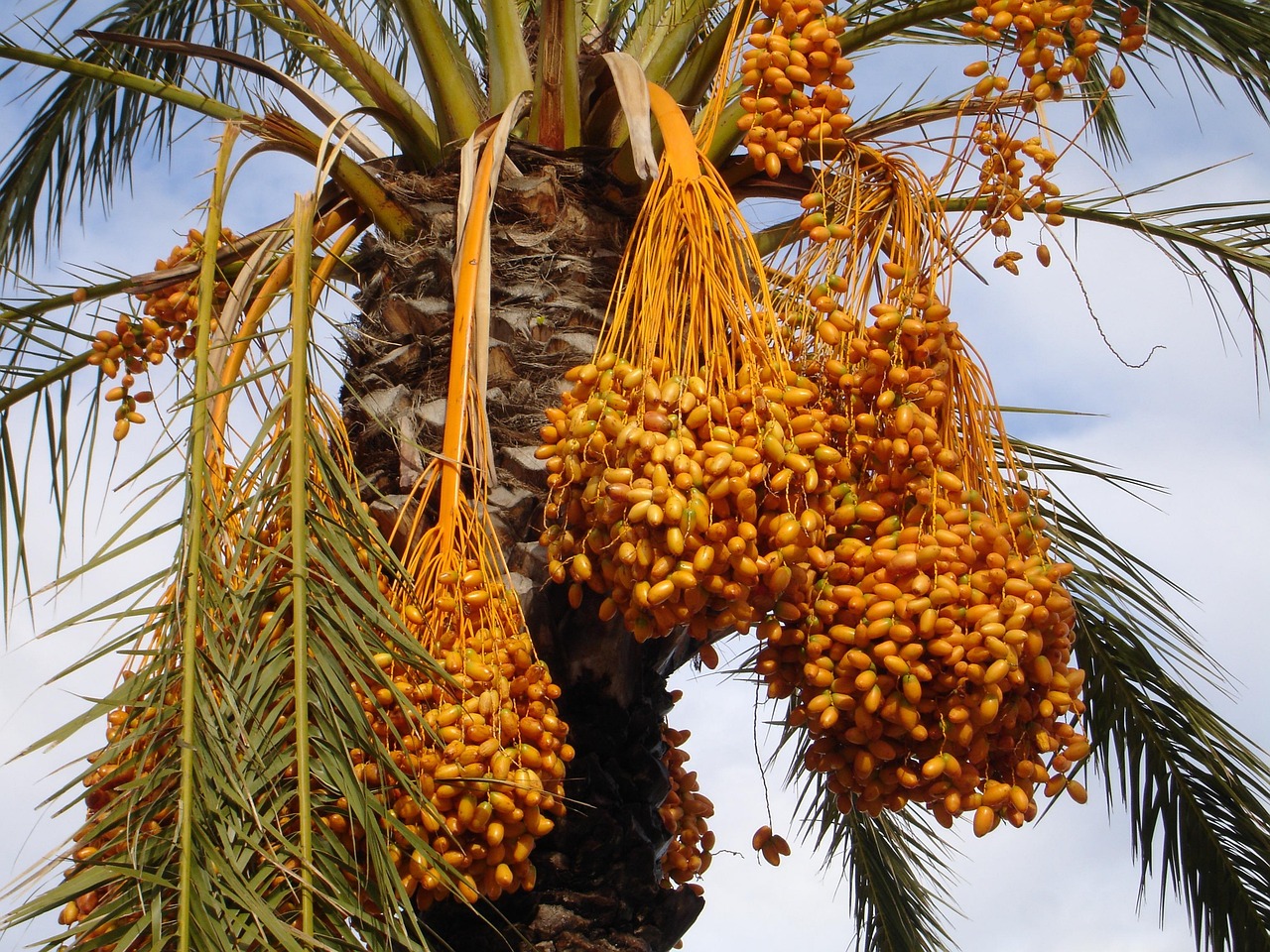Date trees (Phoenix dactylifera) exhibit variable growth rates depending on their environment. In desert plantings, growth rates can be slow, averaging 12 to 24 inches per year, while in oasis settings with optimal water and soil conditions, they can grow up to 36 inches or more annually.
Date palms are iconic plants found in arid regions. They thrive in hot, dry climates, making them a staple in many desert landscapes. These trees are not only valued for their delicious fruit but also for their ability to provide shade and improve soil quality. Understanding their growth rate is crucial for successful cultivation, especially in contrasting environments like deserts and oases.

The growth rate of date trees can vary significantly based on several factors. These include soil type, water availability, temperature, and care practices. In deserts, where water is scarce, date trees may face stress that affects their growth. Conversely, in oasis environments where irrigation is plentiful, date palms flourish and can achieve impressive height and fruit production.
Factors Influencing Growth Rates
Several key factors influence the growth rates of date trees in different environments. These include:
- Water Availability: Adequate irrigation is essential for optimal growth. In arid regions, water scarcity can limit growth.
- Soil Quality: Nutrient-rich soils promote healthier and faster growth. Sandy loam soils are ideal for date palms.
- Temperature: Date trees prefer high temperatures. Optimal growth occurs between 90°F and 100°F.
- Care Practices: Proper pruning, fertilization, and pest control enhance growth rates significantly.
It is important to note that date palms have a long life cycle. They typically take about 4 to 8 years to start producing fruit. During this period, their growth rate can be influenced heavily by the environmental conditions and care they receive.

In addition to these factors, the age of the tree also plays an important role in its growth rate. Younger date palms generally grow faster compared to older trees, which may slow down as they mature.
Growth Rates in Different Environments
The differences in growth rates of date trees in desert versus oasis settings are noteworthy. In deserts, the harsh conditions often limit their potential. The lack of consistent moisture and nutrient availability leads to slower growth rates. Conversely, in oasis environments, date palms benefit from regular irrigation and nutrient-rich soils.
| Environment | Average Growth Rate (inches/year) | Ideal Conditions |
|---|---|---|
| Desert | 12 – 24 | Minimal irrigation, sandy soil |
| Oasis | 24 – 36+ | Frequent irrigation, nutrient-rich soil |
This table summarizes the average growth rates of date trees in both environments, illustrating how critical the surrounding conditions are to their development. The oasis setting provides a stark contrast to the challenging conditions of the desert, showing how agriculture can adapt to different ecological niches.

Sustainable practices in oasis cultivation help maintain the health of the date palms. These practices include using traditional irrigation methods like flood irrigation or modern techniques such as drip irrigation, which conserves water while providing sufficient moisture for the trees.
Understanding these dynamics is crucial for farmers and agriculturalists aiming to maximize the yield of date palms. By tailoring cultivation practices to the specific environmental conditions, growers can enhance the growth rates of their trees and ensure productive harvests.
Water Management Techniques
Effective water management is essential for the successful growth of date palms, especially in arid regions. The techniques employed can significantly influence the growth rates of these trees, particularly in desert and oasis environments. Understanding these methods will help farmers optimize their irrigation practices and enhance palm growth.

Traditional Irrigation Methods
In many regions, traditional irrigation practices have been used for centuries. These methods rely on local knowledge and experience to manage water resources efficiently. Some common traditional techniques include:
- Flood Irrigation: Water is allowed to flow over the field, saturating the soil. This method is effective in areas with significant water availability but can lead to water wastage if not managed properly.
- Surface Irrigation: Water is applied directly to the soil surface through channels or furrows, allowing for even distribution. This method is labor-intensive but can be efficient in specific settings.
- Qanat Systems: An ancient method used in many Middle Eastern countries, qanats are underground channels that transport water from aquifers to the surface, minimizing evaporation losses.
Modern Irrigation Techniques
With advancements in technology, modern irrigation techniques have emerged to optimize water use. These methods focus on delivering precise amounts of water directly to the plant roots. Key modern techniques include:
- Drip Irrigation: This method involves using a network of tubes and emitters to deliver water directly to the base of each tree. It minimizes water waste and is highly efficient.
- Sprinkler Systems: Sprinklers mimic rainfall by distributing water over a wide area. This technique is advantageous for larger plantations but may lead to evaporation losses.
- Subsurface Irrigation: Water is delivered below the soil surface through buried tubes, providing moisture directly to the root zone and reducing evaporation.
Nutrient Management for Optimal Growth
Nutrient management is another critical aspect of date tree cultivation. Proper fertilization can enhance growth rates and fruit production. Different nutrients play various roles in the overall health of date palms.
Key Nutrients for Date Palms
Date palms require several essential nutrients, including:
- Nitrogen (N): Vital for leaf and trunk growth, nitrogen promotes healthy foliage development.
- Phosphorus (P): Important for root development and flower formation, phosphorus enhances fruit yield.
- Potassium (K): Supports overall plant health and improves resistance to diseases and environmental stresses.
- Magnesium (Mg): Aids in photosynthesis by forming chlorophyll, magnesium is crucial for healthy leaf growth.
Fertilization Practices
The timing and method of fertilization can significantly impact the growth rate of date trees. Key practices include:
- Soil Testing: Conduct regular soil tests to determine nutrient levels and deficiencies. This allows for targeted fertilization.
- Balanced Fertilizer Application: Use a balanced fertilizer that provides all essential nutrients. Organic fertilizers like compost can also be beneficial.
- Foliar Feeding: Apply liquid fertilizers directly to the leaves during the growing season to provide a quick nutrient boost.
Pest and Disease Management
Pests and diseases can hinder the growth rates of date palms, making effective management essential for healthy trees. Several common pests and diseases affect date palms, including:
- Date Weevil: This pest damages fruit and can reduce yields significantly if not controlled.
- Red Palm Weevil: A destructive pest that attacks the trunk, leading to tree decline and death.
- Leaf Spot Diseases: Fungal infections that cause leaf discoloration and drop, impacting photosynthesis.
Implementing integrated pest management (IPM) strategies can help mitigate these issues:
- Cultural Practices: Maintain proper sanitation and remove dead or damaged fronds to reduce disease incidence.
- Biological Control: Use natural predators or parasitoids to manage pest populations effectively.
- Pesticide Applications: When necessary, apply pesticides judiciously based on monitoring results and pest thresholds.
A proactive approach to pest and disease management will support healthy growth rates in date palms, ensuring productive harvests over time.
Climate and Its Effects on Date Tree Growth
The climate plays a vital role in determining the growth rate of date palms. Variations in temperature, humidity, and sunlight can significantly affect their health and productivity. Understanding these climate factors is essential for successful cultivation in both desert and oasis environments.
Temperature Requirements
Date trees thrive in warm climates. They require specific temperature ranges to grow optimally:
- Optimal Growth Temperature: Date palms grow best when daytime temperatures are consistently between 90°F and 100°F (32°C to 38°C).
- Cold Tolerance: While date palms can withstand brief periods of cold, prolonged temperatures below 32°F (0°C) can damage young trees and affect fruit production.
- Heat Stress: Excessive heat, especially during flowering and fruit set, can lead to reduced yields. Adequate watering is crucial during these periods to mitigate stress.
Humidity Levels
Humidity is another critical aspect of the climate that affects date palm growth:
- Ideal Humidity: Date palms prefer low to moderate humidity levels. Dry air conditions are favorable for preventing fungal diseases.
- Moisture Stress: High humidity can lead to increased disease pressure, particularly fungal infections, which can hinder growth and yield.
Sunlight Exposure
Date palms require ample sunlight to thrive. Sunlight is essential for photosynthesis, which directly influences growth rates and fruit production.
- Full Sun Exposure: Date palms should receive a minimum of 6 to 8 hours of direct sunlight daily for optimal growth.
- Shade Effects: In shaded environments, date palms may experience stunted growth and reduced fruiting. Care should be taken to ensure that young trees are not overshadowed by larger plants.
Soil Type and Preparation
The type of soil used for planting date palms significantly impacts their growth rates. Proper soil preparation can enhance nutrient availability and water retention, crucial for healthy tree development.
Preferred Soil Conditions
Date palms thrive in well-drained soils, particularly sandy loams. The following soil characteristics are important:
- Drainage: Excellent drainage prevents root rot and other water-related diseases.
- Nutrient-Rich: Soils should be rich in organic matter to support robust growth and nutrient uptake.
- pH Levels: Ideal soil pH for date palms is between 6.0 and 8.0, allowing optimal nutrient absorption.
Soil Preparation Techniques
Proper soil preparation can enhance the growth potential of date palms:
- Tilling: Break up compacted soil to improve aeration and drainage.
- Add Organic Matter: Incorporate compost or well-rotted manure into the soil to enhance fertility and structure.
- Mulching: Apply organic mulch around trees to retain moisture, suppress weeds, and regulate soil temperature.
Pruning Practices for Healthy Growth
Regular pruning is essential for maintaining the health and productivity of date palms. Proper pruning practices help manage growth and improve fruit production.
Benefits of Pruning
Effective pruning offers several advantages:
- Aeration: Pruning enhances air circulation around the tree, reducing disease incidence.
- Light Penetration: Removing excess fronds allows more sunlight to reach the inner canopy, promoting photosynthesis.
- Fruit Quality: Pruning improves the quality of fruit by ensuring that nutrients are distributed more efficiently among developing fruits.
Pruning Techniques
The following techniques can be employed when pruning date palms:
- Remove Dead Fronds: Cut back dead or dying fronds to improve the tree’s appearance and health.
- Crown Cleaning: Thin out crowded fronds to allow better light penetration and airflow.
- Formation Pruning: Shape young trees to develop a strong structure that supports future growth and fruiting.
A well-maintained date palm not only grows more vigorously but also produces higher yields. Pruning should be done carefully to avoid damaging the tree, ideally during the dormant season or after harvest.
Harvesting and Post-Harvest Practices
Harvesting date palms is a critical stage in the cultivation process. Proper timing and techniques are essential for maximizing yield and ensuring fruit quality. The methods employed during this phase can significantly influence the overall success of date production.
Harvest Timing
The timing of the harvest depends on the variety of date palm and the intended use of the fruit. Key indicators for harvest readiness include:
- Color Change: Dates change color from green to yellow or brown as they ripen. This transition signifies that the fruit is approaching maturity.
- Texture: Ripe dates feel soft and yield slightly to pressure. Harvesting should occur before they become overly soft to prevent spoilage.
- Moisture Content: Testing the moisture content can also help determine the ideal harvest time. Dates should be harvested when they contain around 20% moisture for optimal storage.
Harvesting Techniques
Effective harvesting techniques are crucial to minimize damage to the fruit and the tree:
- Hand Harvesting: Workers use long poles with hooks to gently pull down ripe clusters. This method reduces damage compared to mechanical harvesting.
- Mechanical Harvesting: For larger operations, machinery may be used. However, care must be taken to prevent bruising and crushing of the dates.
Post-Harvest Handling
Once harvested, proper handling is essential to maintain quality:
- Cleaning: Remove any debris or damaged fruit before packaging to prevent spoilage.
- Cooling: Quickly cooling dates after harvest helps extend shelf life. Refrigeration or controlled atmosphere storage can help maintain freshness.
- Packing: Dates should be packed carefully to avoid bruising, using suitable containers that allow for ventilation.
Economic Considerations in Date Palm Cultivation
The economic viability of date palm farming is influenced by various factors, including market demand, production costs, and environmental sustainability. Understanding these aspects can aid farmers in making informed decisions.
Market Demand
The global demand for dates has been rising due to their nutritional benefits and versatility in culinary applications. Key market considerations include:
- Export Potential: Many countries import dates, creating opportunities for growers to expand their market reach.
- Diverse Uses: Dates are used in snacks, desserts, and health food products, increasing their marketability.
Production Costs
The costs associated with date palm cultivation include:
- Irrigation Systems: Investment in efficient irrigation technology can lead to better yields and water conservation.
- Labor Costs: Labor is a significant expense, particularly during harvesting and maintenance periods.
- Pest Management: Implementing integrated pest management strategies can incur initial costs but may lead to long-term savings through reduced crop loss.
Sustainability Practices in Date Palm Cultivation
Sustainable practices are vital for ensuring the long-term viability of date palm farming. These practices help conserve resources while maintaining productivity.
Water Conservation Strategies
Given the arid nature of many date-growing regions, water conservation is paramount:
- Efficient Irrigation: Utilizing drip irrigation can significantly reduce water usage compared to traditional methods.
- Rainwater Harvesting: Collecting and storing rainwater can provide additional irrigation resources during dry periods.
Soil Health Management
Maintaining soil health is essential for sustainable date palm production:
- Crop Rotation: Rotating date palms with other crops can improve soil fertility and reduce pest build-up.
- Organic Fertilizers: Using organic amendments enhances soil structure and promotes beneficial microbial activity.
Conclusion
The growth rate of date trees in desert and oasis settings is influenced by a multitude of factors including climate, soil conditions, water management, and pest control. Understanding these variables plays a crucial role in optimizing cultivation practices. Farmers can achieve healthier trees and higher yields by implementing effective irrigation systems, nutrient management strategies, and sustainable practices. As global demand for dates continues to rise, careful attention to these aspects will ensure the continued success and profitability of date palm farming. Embracing both traditional knowledge and modern technology will provide a balanced approach toward achieving sustainable agricultural practices in the cultivation of date palms.
